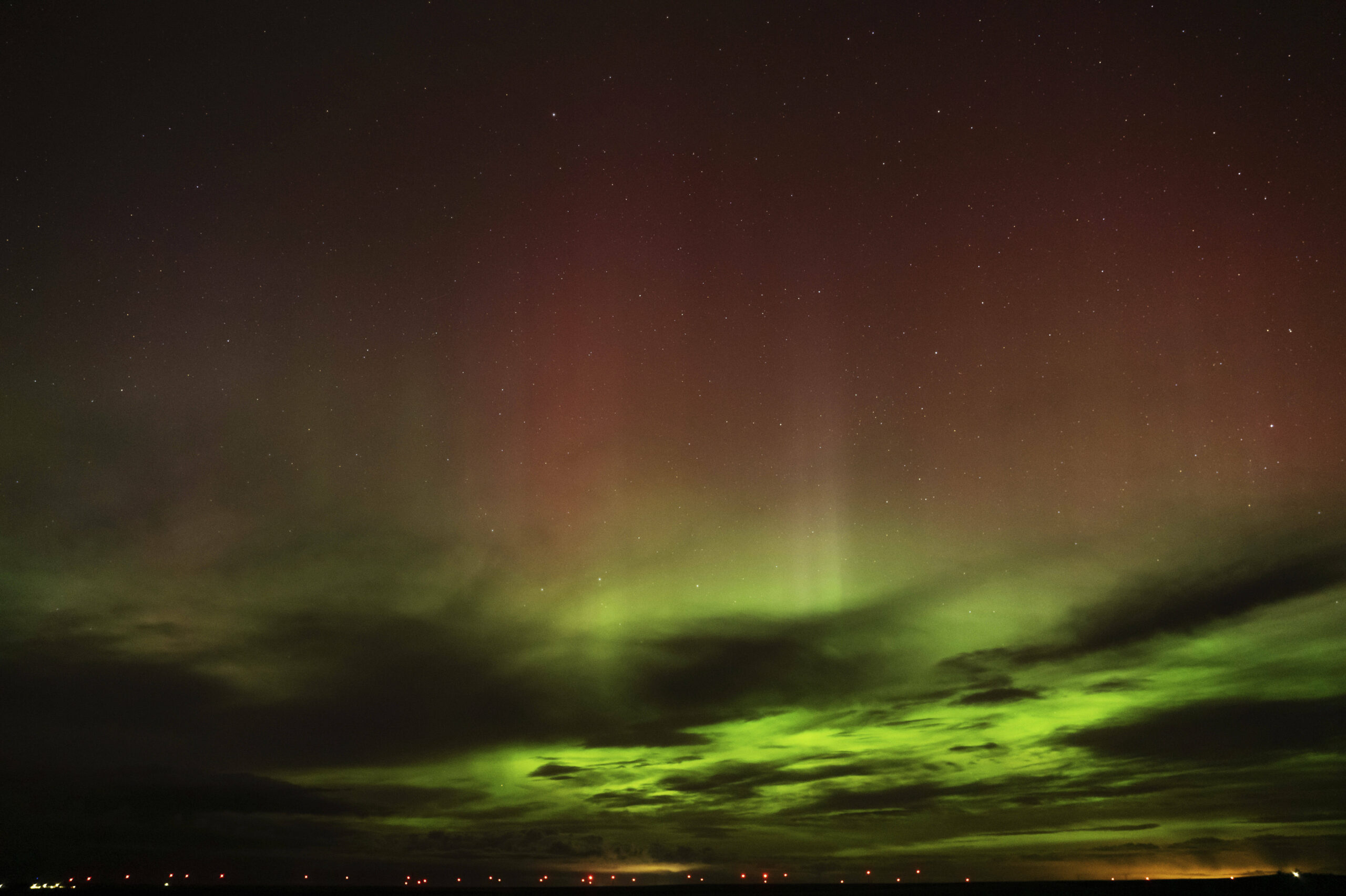
Update, 9 a.m. Thursday:
An updated forecast for this week’s northern lights display shows they won’t be as visible in the mainland U.S. as previously thought.
A previous forecast by the University of Alaska Fairbanks said the aurora would be visible in more than a dozen states.
The university now says the previous forecast derived from a long-term forecast based on the sun’s rotation that went back 54 days. The features it observed on the sun typically last one to three months, which led to its initial report, Rod Boyce, a spokesperson for UAF’s Geophysical Institute, said Wednesday.
“However, now that the forecast activity is less than three days in the future, we can see that the solar features that produced the prior activity have actually diminished over the last month,” he said.
In North America, the revised predictions show a broad stretch of Canada and Alaska could see the northern lights overhead Thursday. Those in small slices of the contiguous U.S. — including parts of Wisconsin, Michigan and Montana — could also get a peek.
Geomagnetic storms are classified G1 (minor) through G5 (extreme) on the Kp-index, or planetary index. A G1 storm has a Kp-index of 5, while a G5 storm has a Kp index of 9.
“You really got to get higher levels of storming really to be visible in the U.S., but the G2 prediction has since been degraded down to G1 or less,” Bill Murtagh, the program coordinator for the National Oceanic and Atmospheric Administration’s Space Weather Prediction Center, said Wednesday.
The Associated Press contributed information to this story.
Original story:
The northern lights are expected to be visible across Alaska and many other northern U.S. states this week, according to the University of Alaska Fairbanks.
On Wednesday and Thursday, the Kp-index, or planetary index, will be at four, indicating active displays. The scale goes all the way up to nine, and any occurrence above five is considered a geomagnetic storm.
“Weather permitting, active auroral displays will be visible overhead from Utqiaġvik to Anchorage and Juneau, and visible low on the horizon from King Salmon and Prince Rupert,” staff at UAF’s Geophysical Institute wrote in a notice for both days.
The institute has also forecast auroral activity on Thursday for Oregon, Washington, Idaho, Montana, Wyoming, North Dakota, South Dakota, Minnesota, Wisconsin, Michigan, New York, New Hampshire, Vermont, Indiana, Maine and Maryland.
On Wednesday, the storm will be highly visible “low on the horizon from Seattle, Des Moines [Iowa], Chicago, Cleveland, Boston, and Halifax [Nova Scotia].”
On Thursday, the storm will get stronger and can be seen overhead in Minneapolis, Milwaukee; Bay City, Mich., and on the horizon in Salem, Mass.; Boise, Idaho; Cheyenne, Wyo.; Lincoln, Neb.; Indianapolis, and Annapolis, Md.
What happens during a geomagnetic storm?
During the storm, a coronal hole (the spots that appear black on the sun) prompts high winds, which in turn, trigger coronal mass ejections, or CMEs. A CME projects plasma and pieces of the sun’s magnetic field into the atmosphere.
“CMEs typically take several days to arrive at Earth, but have been observed, for some of the most intense storms, to arrive in as short as 18 hours,” NOAA’s Space Weather Prediction Center says.
What is an aurora?
The sun’s activity is volatile, and in some cases, the disturbances are so strong they can pull the Earth’s magnetic field away from our planet.
But, like a taut rubber band when it’s released, the magnetic field snaps back, and the force of that recoil creates powerful ripples known as Alfvén waves about 80,000 miles from the ground. As those waves get closer to Earth, they move faster thanks to the planet’s magnetic pull.
Sometimes electrons hitch a ride on these superfast Alfvén waves, reaching speeds as high as 45 million mph as they hurtle downward.
“Think about surfing,” Jim Schroeder, an assistant professor of physics at Wheaton College who has led research on the process. “In order to surf, you need to paddle up to the right speed for an ocean wave to pick you up and accelerate you, and we found that electrons were surfing. If they were moving with the right speed relative to the wave, they would get picked up and accelerated.”
When the electrons reach Earth’s thin upper atmosphere, they collide with nitrogen and oxygen molecules, sending them into an excited state. The excited electrons eventually calm down and release light, which is what we see as the aurora.
How to view the aurora
The Space Weather Prediction Center says the best time to view the aurora is usually between 10 p.m. and 2 a.m. local time.
You don’t need any special equipment to see auroras.
- Pick a spot where there is little light pollution.
- Get to a higher elevation if possible.
- Check the forecast for signs of clouds or precipitation, which could block your view.
- Scan the skies — while northern is in the name, they can appear from all directions.
The Associated Press contributed information to this story.
9(MDQ2OTU5NjExMDE2MTkwMTE2MDExMzAxYg000))




